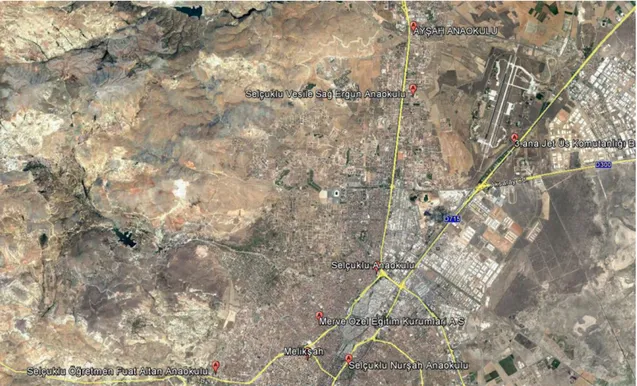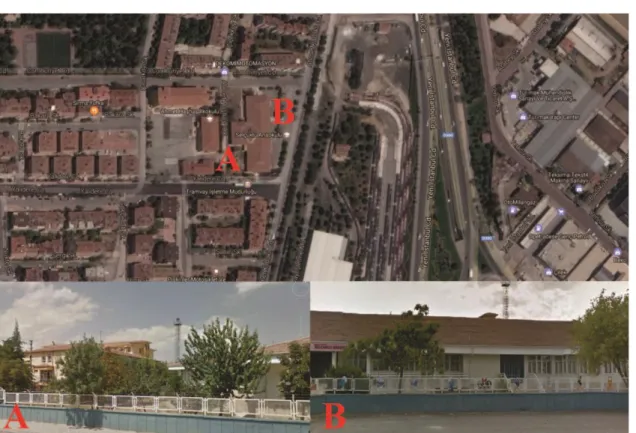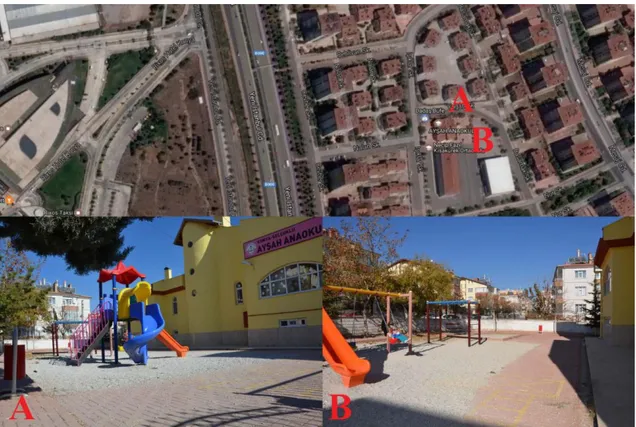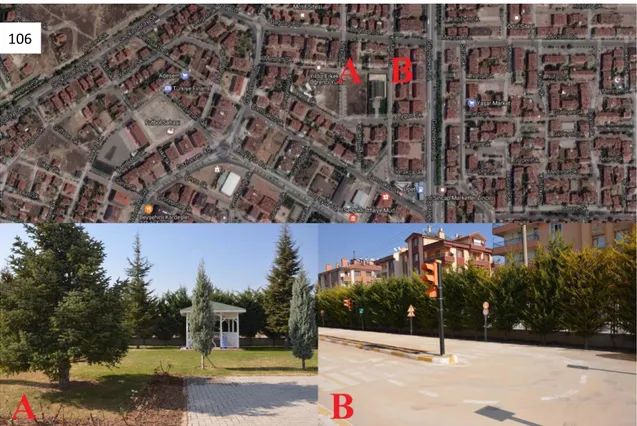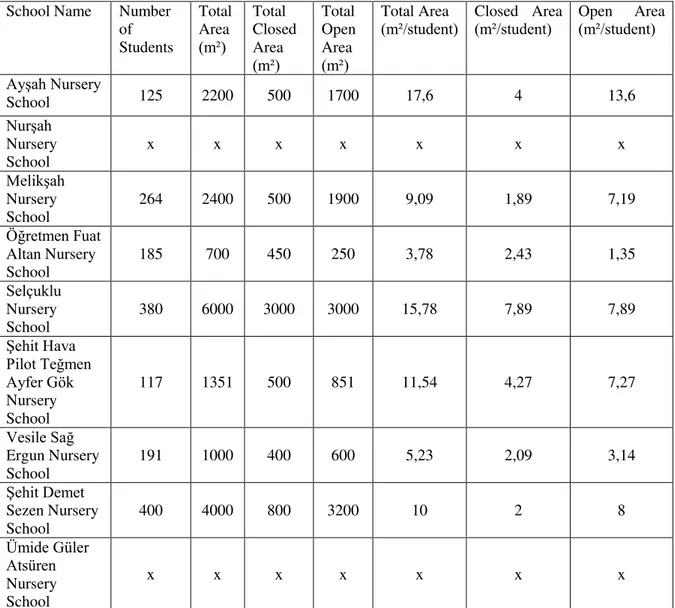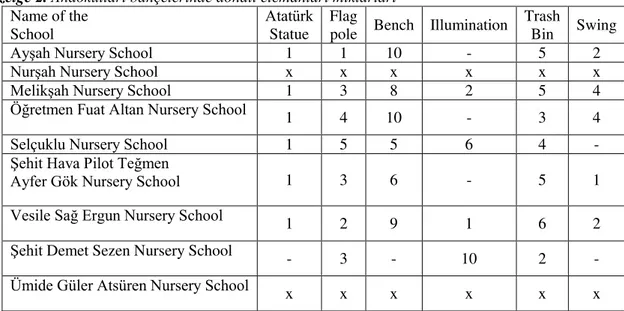Gaziosmanpaşa Üniversitesi Ziraat Fakültesi Dergisi Journal of AgriculturalFaculty of GaziosmanpasaUniversity
http://ziraatdergi.gop.edu.tr/ Araştırma Makalesi/ResearchArticle JAFAG ISSN: 1300-2910 E-ISSN: 2147-8848 (2017) 34 (1), 153-163 doi:10.13002/jafag4193
Examining the Gardens of Preschool Educational Institutions in Terms of Landscape
Design and Space Usage: Example of Selçuklu District
Sertaç GÜNGÖR
1*1
Selcuk University Faculty of Agriculture Department of Landscape Architecture, Konya *e-mail: sertac@selcuk.edu.tr
Alındığı tarih (Received): 13.12.2016 Kabul tarihi (Accepted): 05.03.2017
Online Baskı tarihi (Printed Online): 17.04.2017 Yazılı baskı tarihi (Printed): 02.05.2017
Abstract: The usage of school gardens, the nature of the reinforcement elements used, the amounts of green spaces
per capita and the plant species used are very important for the healthy development of children's physical, mental and social relations in the pre-school childhood period. This study was carried out in 7 nursery schools to determine the current situations of the gardens in pre-school educational institutions in Selçuklu district of Konya city for landscape design and space usage and to put forward solution proposals. The results of this study showed that gardens of the nursery schools were not used effectively, because there were not sufficient area for the green space in landscape design, and gardens of nursery schools were not designed properly to contribute to children's mental and physical development.
Keywords: Pre-school, School garden, Landscape design, Space usage, Konya/Turkey
Okul Öncesi Eğitim Kurumlarının Bahçelerinin Peyzaj Tasarımı ve Alan Kullanımları Bakımından İncelenmesi: Selçuklu İlçesi Örneği
Öz: Okul öncesi çocukluk döneminde, çocukların fiziksel, zihinsel ve sosyal ilişkilerinin sağlıklı bir biçimde
gelişebilmesi için okul bahçelerinin, kullanım şekli, kullanılan donatı elemanlarının niteliği, kişi başına düşen yeşil alan miktarları ve kullanılan bitki türleri çok önemlidir. Konya Kenti Selçuklu ilçesi okul öncesi eğitim kurumlarındaki bahçelerin, peyzaj tasarımı ve alan kullanımına yönelik mevcut durumlarının saptanabilmesi ve çözüm önerilerinin ortaya konulabilmesi için izin alınabilen 7 adet anaokulunda inceleme gerçekleştirirmiştir. Bu çalışma sonucunda; incelenen anaokulu bahçelerinin etkin kullanılmadığı, peyzaj tasarımında yeşil alana yeterince yer verilmediği ve anaokulu bahçelerinin çocukların zihinsel-fiziksel gelişimine katkı sağlayacak biçimde tasarlanmadığı tespit edilmiştir.
Anahtar kelime: Okul öncesi, Okul bahçesi, Peyzaj tasarımı, Alan kullanımı, Konya
1. Introduction
Preschool educational institutions have important roles in terms of maximizing children’s development and creativity potential. Preschool educational institutions should provide students with high-quality learning settings by taking into consideration factors such as age, development level, interests and needs (Durmuşoğlu 2008).
First six years of the human lives comprise the most crucial time period in which a child's development is fast and personality begins to be shaped. 70% of the children's mental, emotional, social and physical development is completed
between 0 to 6 years. The period of 0-6 years, which is called the preschool period, is the period during which the learning of the child is the most intense and the basic habits and mental abilities develop and are shaped in the fastest way. It is accepted that the behaviors gained during this period continue throughout the life. Moreover, it is highly important for parents and educators to get to know their children, to make sense of what they have experienced and to guide them in this direction in such an important period (Uluğ and Karadeniz 2011).
GÜNGÖR/ JAFAG (2017) 34 (1), 153-163 Preschool education ensures that individuals
are more productive and efficient in adulthood period and completely use the potential they possess by supporting their social and emotional development. Furthermore, it constitutes the fastest and the most sensitive period of human development. The education obtained and the experiences gained in the first years of life have significant impacts on learning ability in the following ages and success in the future (Yavuzer, 1997).
The primary duty of preschool educational institutions is to introduce a qualified educational environment to children and to provide them with the environment and materials they need in order to learn. In addition, providing children from different socioeconomic levels with equality of opportunity in education and preparing them for primary school are also among the objectives of preschool education. All the environments introduced to the child will contribute to the child’s development and education either positively or negatively. Whereas an environment designed in accordance with the good, correct and desired characteristics support all the areas of the child’s development positively, it can be also stated that failure of designating environments can increase the risk of the child’s development. A well-designed educational environment is expected to be secure, and multi-purpose environments which are convenient for the developmental characteristics of children improve problem-solving skills and encourage creativity (Kılıç, 2013).
Preschool education can optionally provide the education of 36-72-month-old children who have not reached to the age of compulsory primary education. Preschool educational institutions are opened as nursery schools within the scope of independent nursery schools, formal and non-formal educational institutions of which physical capacity is suitable (Poyraz, 2001).
Nowadays, the children especially in big cities grow up isolated from nature. Due to quite limited secure open spaces (park, playground, urban forest, square, etc.) as a consequence of irregular and unplanned constructions in cities, many
children spend most of their time indoors, and they are often restricted to contact with the society and nature. In urban spaces, natural playgrounds and traditional group games have disappeared, free playing time has been removed, and playing has been isolated from nature and people due to institutionalization. The fact that children gradually watch more television and play computer games isolates them from the social environment. Spending time with various media tools can be replaced with more active and meaningful occupations such as reading, sport activities or playing with friends. Television causes children to become mentally passive and prevents creative playing activities. In fact, the game is the most effective way which prepares the child for the adult life and it is a serious activity for the child. As children play a game, their skills improve, and their abilities develop (Çelik, 2012).
Traditionally, outdoor playgrounds are designed to facilitate children a play zone and are intended to enhance their physical, social, emotional and cognitive development. Even though traditional playgrounds are anticipated to promote children to play, the design of these areas does not meet children’s needs for exploring their environment. The traditional playground is typically flat, barren, covered with asphalt, and equipped with climbing bars, a swing, a sandpit, a seesaw, and a slide. Also, the equipment designed for these playgrounds is generally made of metal. Such playgrounds have not been found to be very challenging and even very young children or those with motor behavior deficits do not explore their potential on these playgrounds. Natural environments represent different play opportunities for children. The rough surface provides movement challenges, and topography and vegetation provide a diversity of different designs for playing and moving. To address these problems, this study documents and discusses the importance of natural environments in children’s play, physical activity and motor development (Fjørtoft 2004).
The development of children who play either by themselves or with their friends in the garden is identified primarily in 4 ways as follows: 154
GÜNGÖR/ JAFAG (2017) 34 (1), 153-163 Physical development,
Psychomotor development,
Emotional and social development and mental power and development (Özgen, 1997)
School gardens which will be organized in accordance with the physical and mental developmental needs of children will become the places which provide social experience and meaningful motion activities. These places are effective especially during breaks which are considered as a rhythmic factor in school life. Breaks are the periods of concentration and mental relief time periods following the lack of motion (motionlessness) during the lesson, and they can specifically facilitate motion, playing and sports, relaxation and feeling at ease. Students’ comfort during breaks and their active participation in activities will experimentally reduce the act of aggression against people and objects, and will encourage their healthy development (Özdemir, 2011).
Physical conditions consist of the specifications of the school buildings and their interior / exterior environments. The structure of these buildings is determined by the relevant regulations of the Ministry of National Education and detected in cooperation with the Ministries of the Interior, Health and Tourism. The basic principles set such issues as the distance of schools to markets, stores, entertainments, hotels, and prisons etc... The purpose of it was to build the school districts in a way proper to the construction of projects and the architecture of schools, spatial places that meet the qualities and quantities, and also contain sufficient tools. It provides an attention to their usage, maintenance, protection and most importantly security measures. It also facilitates all kinds of physical structuring such as Ataturk corners and outdoor / garden regulations. In the history of education the discussion of the appropriacy of schools’ spatial / physical environments for education experiences and objectives is an ongoing current issue and it is crucial (Pedük et all. 2014).
In this context, the design and management of the school garden bear great importance with regard to the fact that playing outdoors increases and maintains the benefits it provides to children. The determination of the current features of the school garden will constitute the first step in terms of designing qualified school gardens and providing their sustainability with the effective management applications (Kalburan, 2014).
2. Materials and Methods 2.1. Material
This study was carried out in Selçuklu central district of Konya. The province consists of 3 central districts. Selçuklu central district is located on a developmental axis in the north of Konya. The information on 7 nursery schools which are preschool educational institutions in study area constitutes the main material of this study. All the schools are located in the city center and within settlement areas. 9 private nursery schools and 8 state nursery schools in total are present in the district.. 9 state nursery schools are shown in Figure 1. Although 9 nursery schools exist in the district in total, the administrators of 2 nursery schools did not want to participate in our study.
GÜNGÖR/ JAFAG (2017) 34 (1), 153-163
Figure 1. The locations of the nursery schools included in the study in Selçuklu District of Konya.
Şekil 1. Çalışmaya dahil edilen anaokullarının Konya Kenti Selçuklu İlçesindeki konumları
2.2 Methods
This study was carried out in the fall education term of 2016. and the “form of the knowledge acquisition about the area” was created in accordance with our objective. In the knowledge form, open and closed areas of schools, the presence of equipment elements (Table 2), play tools (Table 3) and plant species with their usages were examined, observed on-site and recorded. The situation of school gardens in terms of landscape design was compiled and supported with satellite imaging by obtaining numeric data related to our study area34yg from Konya Provincial Directorate of National Education and school administrations and by conducting face to face interviews with teachers.
3. Findings
School gardens are defined as “external environments” of schools disregarding whether they are big or small, well-kept or neglected, inactive or with the potential for action. Regardless of the conditions, each one is described as a health indicator of the society. It was observed that unimproved school gardens
characteristics of which deteriorated produce negative messages about the school and neighborhood in which they are located, and that active and dynamic school gardens breathe new life to both (Aslan, 2010).
While planning outdoor playgrounds, children should benefit from research, observation, problem solving and development and learning via trial and error. Roads, plants, and different surfaces should be used in forming creative activities. Empty plots of the ground will provide children to communicate with nature. Natural grass and shading trees are expected to exist in open playgrounds (Kubanç, 2014).
The areas which should necessarily exist in preschool educational institutions for the mental and physical development of children are as follows.
Soil area (for the works with nature): a small cultivable soil area should be present for children to be able to plant various plants in a corner of the garden and to create a vegetable and flower garden.
Grass area: an area formed by well-kept grass species, which are resistant to being stepped on, 156
GÜNGÖR/ JAFAG (2017) 34 (1), 153-163 for children to play mobile games such as
jumping, somersaulting, running, etc.
Woody area: an area which will shade a part of the playground and consists of thornless trees and shrubs with non-allergenic leaves and fruit, and poison free;
Sand area: an enclosed, sand or bark chips laid area which is always kept clean and on which children can play with a shovel and a bucket. (The chip can be laid under the playing tools)
Firm ground road made of various materials: an area created of wooden or compressed material.
Storage area: an area suitable for storing various materials and tools used in the garden in an open or closed space.
Water play area: a small area which has a drainage and a water source and in the garden of
which children can play with water (Özgen, 1997).
Furthermore, a number of factors should be considered when choosing trees and shrubs for the school ground. The following principles will help to ensure that the unique characteristics and features of your region and school ground are central to the plant-selection process (Campbell 2013):
Although landscape designs were performed on wall fronts surrounding the school gardens, school gardens were mostly covered with the concrete surface. It was observed that more trees and shrubs were planted in Şehit Demet Sezen and Selçuklu nursery schools when compared to other schools. Figure 2 shows the satellite image of the Selçuklu nursery schools and pictures taken from the marked places A and B.
Figure 2. Google view of Selçuklu nursery school.
Şekil 2. Selçuklu Anaokulunun Google map görüntüsü
Grass areas on which children can play bare feet in order to blow off steam and to dispose of the static electricity accumulated in their bodies are limited in all nursery schools and are present a
little more in Şehit Demet Sezen and Selçuklu nursery schools.
In 7 nursery schools included in the study, while front gardens were utilized as ceremony 157
GÜNGÖR/ JAFAG (2017) 34 (1), 153-163 areas in which the bust of Atatürk and Flag poles
occur, a combination of play sets with which children can play is present in back gardens. There was not any toys or combinations found in Şehit Demet Sezen Nursery School. Playgrounds have been utilized in the inner space, in other nursery schools, playgroups with which children can play are situated in the garden.
In addition, only 3 out of 7 nursery schools had sand play areas. They are Ayşah, Şehit Hava Pilot Teğmen Ayfer Gök, and Şehit Demet Sezen nursery schools. Figure 3 shows the satellite image of the Ayşah nursery school and pictures taken from the marked places A and B.
Figure 3. Google view of Ayşah nursery school.
Şekil 3. Ayşah Anaokulunun Google map görüntüsü
There is no water play area (fountain etc.) in any of the nursery schools.
A traffic education park and traffic signs are present in the gardens of Ayşah nursery school and Şehit Demet Sezen nursery school in contrast to other schools. The existence of these areas was considered as positive since it will contribute to the child development.
Hobby gardens were designed for children in the gardens of Şehit Hava Pilot Teğmen Ayfer Gök, Şehit Demet Sezen, and Öğretmen Fuat Altan nursery schools. Figure 4 shows the satellite image of the Şehit Demet Sezen nursery schools and pictures taken from the marked places A and B.
GÜNGÖR/ JAFAG (2017) 34 (1), 153-163
Figure 4. Google view of Şehit Demet Sezen nursery school.
Şekil 4. Şehit Demet Sezen Anaokulunun Google map görüntüsü
Regarding the sizes, number of students of nursery school gardens located in Konya Selçuklu district and the amount of open/closed areas per student can be seen from Table 1. The largest garden area belongs to Şehit Demet Sezen nursery school with 3200 m2 and the smallest garden area belongs to Öğretmen Fuat Altan nursery school with 250 m2. The biggest open area per student belongs to Ayşah nursery school with 13,6 m2
and the smallest open area per student belongs to Öğretmen Fuat Altan nursery school with 1,35 m2.
School and school garden are a space and means for children and their healthy development. Thus, the number of students studying at school, the age, gender, mental and physical developmental conditions of children and their
characteristics should be considered and evaluated. The evaluations to be carried out will be a guide way with regard to what kind of school garden design is needed for the educational, social and physical development of children. In this way, it will be ensured that different activity areas can be meaningfully designed in school gardens and a great variety of action and play opportunities, resting and retreat opportunities for relaxing and chatting can be defined. The adjustments to be carried out and the opportunities to be presented will not only contribute to creating and developing a school garden concept, but also they will encourage the characteristics of the school to reach a perceptible level (Özdemir, 2011).
106
GÜNGÖR/ JAFAG (2017) 34 (1), 153-163
Table 1. Garden area amount per capita of the nursery school gardens located in Konya Selçuklu district (m2)
Çizelge 1. Konya Selçuklu ilçesinde bulunan anaokulu bahçelerinde kişi başına düşen bahçe alan
miktarı (m2 )
School Name Number of Students Total Area (m²) Total Closed Area (m²) Total Open Area (m²) Total Area
(m²/student) Closed Area (m²/student) Open (m²/student) Area Ayşah Nursery School 125 2200 500 1700 17,6 4 13,6 Nurşah Nursery School x x x x x x x Melikşah Nursery School 264 2400 500 1900 9,09 1,89 7,19 Öğretmen Fuat Altan Nursery School 185 700 450 250 3,78 2,43 1,35 Selçuklu Nursery School 380 6000 3000 3000 15,78 7,89 7,89 Şehit Hava Pilot Teğmen Ayfer Gök Nursery School 117 1351 500 851 11,54 4,27 7,27 Vesile Sağ Ergun Nursery School 191 1000 400 600 5,23 2,09 3,14 Şehit Demet Sezen Nursery School 400 4000 800 3200 10 2 8 Ümide Güler Atsüren Nursery School x x x x x x x
Lower points of the physical environments of preschool with in the government primary schools than the points of preschool with in the private primary schools, private preschools. And autonomous preschools revealed that school type influences physical environment. Some reasons such as high numbers of preschool with in the government primary schools need for budgets related to building and equipment in other classes of elementary education caused some inadequacies in the physical environments of
these institutions. On the other hand, autonomous preschools are the institutions solely built by considering pre-school education criterions. It’s not a surprising result to have suitable conditions for physical environments of these institutions. In the same way, high fees of preschool with in the private primary schools and private preschools provide positive contributions to the physical environments of these institutions (Erbay and Ömeroğlu, 2009).
GÜNGÖR/ JAFAG (2017) 34 (1), 153-163 Table 2. The number of equipment tools in nursery school gardens
Çizelge 2. Anaokulları bahçelerinde donatı elemanları miktarları
Name of the School
Atatürk Statue
Flag
pole Bench Illumination
Trash
Bin Swing
Ayşah Nursery School 1 1 10 - 5 2
Nurşah Nursery School x x x x x x
Melikşah Nursery School 1 3 8 2 5 4
Öğretmen Fuat Altan Nursery School 1 4 10 - 3 4
Selçuklu Nursery School 1 5 5 6 4 -
Şehit Hava Pilot Teğmen
Ayfer Gök Nursery School 1 3 6 - 5 1
Vesile Sağ Ergun Nursery School 1 2 9 1 6 2
Şehit Demet Sezen Nursery School - 3 - 10 2 -
Ümide Güler Atsüren Nursery School x x x x x x
Table 3. The number of play tools in nursery school gardens
Çizelge 3. Anaokulları bahçelerinde oyun elemanları miktarları
Name of the School
Slide Combined
Toys Playground
Climbing
Toy Seesaw Pergola Pogo stick
Ayşah Nursery School 1 1 1 - - - -
Nurşah Nursery School x x x x x x x
Melikşah Nursery School 5 1 2 - 2 1 -
Öğretmen Fuat Altan
Nursery School 3 1 1 - - 1 -
Selçuklu Nursery School 4 1 1 - - - 2
Şehit Hava Pilot Teğmen
Ayfer Gök Nursery School 1 1 1 - 2 1 -
Vesile Sağ Ergun Nursery
School 3 2 1 1 - 1 -
Şehit Demet Sezen Nursery
School - - - 2 -
Ümide Güler Atsüren
Nursery School x x x x x x x
It was observed that nursery school gardens which can be regarded as spaces for children in the study area were not designed sufficiently to providing opportunities for the outside activities of children. In the light of the data obtain from the school gardens do not meet the needs of students such as social learning (communication, experience, etc.), motion (running, jumping, climbing, crawling, etc.), and resting (relaxing, sitting, lying, etc.).In addition the designs in these
school gardens show great similarity in terms of the landscape design.
According to Fjørtoft 2004, a functional approach to the environment corresponds well to children interactions and children intuitively use their environment for physical challenges and play. Children perceive the functions of the environment and use them for play. In the context of the present study, functions refer to the structure and complexity of the environment. The complexity of the environment was defined as the 161
GÜNGÖR/ JAFAG (2017) 34 (1), 153-163 variety in landscape forms and structure, and
variety in vegetation such as phytosociology and physiognomy.
Children play and use different play equipments in the playgrounds of preschools and kindergartens which support children’s development from different aspects. Despite these, usually playgrounds of educational institutions do not have appropriate qualities and meet children’s expectations. From this perspective, it is important to determine equipment’s in actual playgrounds of preschool institutions to build children’s dream playgrounds. Therefore, the aim of this study is to analyse children’s drawings about actual playgrounds of
their schools and playgrounds in their dreams (Salı et all. 2014).
An empty space, a garden or a hall for playing games will help the emergence of many talents of the children. A child who is acquainted with the nature in a garden whose surrounding is maintained and which is furnished with well-chosen and placed game materials also learns to cope with the challenges faced there. Remembering that garden tools and materials, too, support the creativity of mind, in pre-school education institutions, certainly a garden must be planned which is accordance with the child and where the child alone or in groups can plan and execute games, and where there are tools and devices (Yılbaş et all. 2015).
4. Conclusion
Determining the problems and imperfections in the current situation is the most significant requirement in order to perform good planning and design for the effective use of school gardens. In this study the nursery schools problems are identified and they are as follows;
The combined or single toys in the playgrounds made of plastic rather than natural materials were preferred.
The plastic floor which contains chemical substances was observed as a flooring under the play groups in some school gardens.
There are schools which have no play groups in the open space.
The amount of open space per child differs considerably among the schools.
No social areas in which children can be actively educated outdoors exist.
Open spaces were not designed effectively in nursery schools. Nursery schools with no landscape design were identified.
In nursery schools with sand pools were inactive. They are not presented to students’ use for cleaning issues.
Entrance security cabins which will provide children’s safety are present only in some schools.
“Creative” play groups which will encourage different physical activities of children were not encountered in any school.
Inclined/moving areas which will motivate children to motion were not encountered in any school garden.
Water is not present as a playing element in any school.
The number of equipment elements in some schools is quite insufficient.
The playgrounds of children were generally designed in cold colors.. Warm colors which will excite and encourage them to play were not used.
A waste collection unit in which waste and recycle products can be separated for the purpose of providing children with environmental awareness was encountered only in one school.
Top-covered, half open spaces do not exist, except for in a few schools.
The nursery school should be improved in Selcuklu by providing aforementioned needs to reach the required level.
The effects of landscape on children should be explained to the school administration. It helps to gain awareness and determine appropriate necessities for the ministries. School gardens occupy a significant place in the development of children. Thus, the landscape designs may provide children’s interact with the outside world and benefit from the elements in the outside. It also contributes to children development in school gardens.
The locations of the schools which were converted from an apartment and the gardens of
GÜNGÖR/ JAFAG (2017) 34 (1), 153-163 which are not big enough, these are also some
other problems that should be changed. The nursery schools need to be designed within larger areas to provide open spaces. Hence, the schools should be redesigned by adding elements which encourage motion, are far from monotony and will draw children’s attention. It is also crucial to improve sufficient grass surface occurancein the nursery schools.
Shade areas should be provided via plantation. Thornless/nonpoisonous fragrant colorful plants which have no allergenic properties should be used in the open spaces in the schools.
The children's contact with different textures should be ensured by using different materials on firm grounds.
Every nursery school can be designed with different concepts within itself. The design of school gardens is an important subject which requires expertise. It is fundamental to create ergonomic designs for children.
As a result of this study, it was ascertained that the nursery school gardens in Selçuklu district of Konya province are not at the sufficient level. It should be ensured that open spaces are more qualified. Studies should be carried out by experts from many occupations such asarchitect, landscape architect, pedagog, artistetc.. working together. Well-designed gardens will add specific identity to the school and contribute to the students at the ages of their development.
References
Aslan F (2010). Okul Öncesi Eğitim Kurumlarında Dış Mekan Tasarımında Çocukların Beklentilerinin Belirlenmesi. Doktora Tezi. Ankara Üni. Fen Bilimleri Enstitüsü, Ankara 16 sf.
Campbell H (2013). Landscape and child development: A design guide for early years-kindergarten play-learning environments, Evergreen, 2nd ed.
Çelik A (2012). Okul Öncesi Eğitim Kurumlarında Açık Alan Kullanımı: Kocaeli Örneği. Atatürk Üni. Ziraat Fak. Dergisi 43 (1): 79-88.
Durmuşoğlu M C (2008). An examination on the opinions of preschool teachers about the preschool learning settings in their schools. Egitim Arastirmalari-Eurasian Journal of Educational Research, 32, 39-54. Erbay F, Ömeroğlu E (2009). Examination of pre-school
educational environments in respect of some variables, Procedia - Social and Behavioral Sciences, Volume 1, Issue 1, 2009, Pages 42-45, ISSN 1877-0428. http://dx.doi.org/10.1016/j.sbspro.2009.01.011.
Fjørtoft I (2004). Landscape as Playscape: The Effects of Natural Environments on Children’s Play and Motor Development. Children, Youth and Environments 14(2), 21-44.
Kalburan N C (2014). Denizli ilinde bulunan resmi ve özel anaokulu bahçelerinin karşılıklı olarak incelenmesi. Pamukkale Üni. Sosyal Bilimler Enstitüsü Derg. Sayı 18, sf 99-113.
Kılıç Z (2013). Anasınıfına Devam Eden Çocukların Okul Bahçesinde Görmek İstedikleri Ortam Özelliklerinin Belirlenmesi. Ankara Üniversitesi Eğitim Bilimleri Enstitüsü Yüksek Lisans Tezi. Ankara.
Kubanç Y (2014). Physıcal Examınatıon Of The State Of Preschool Educatıon Instıtutıons. The Journal of International Social Research. Volume:7, Issue:31, 681.
Özdemir A (2011). Okul Bahçesi Peyzaj Tasarım Anlayışındaki Değişim ve Bu Değişimin Uygulamaya Yansımalarının Bartın Kenti Örneğinde İrdelenmesi. Bartın Orman Fakültesi Dergisi Cilt: 13, Sayı: 19, 41-51
Özgen Y (1997). Eğitim Kurumlarındaki Oyun Çağı Çocuklarının Bahçe Donatıları ve Araçları Üzerine Bir Araştırma. İstanbul Üni. Orman Fak. Derg. Cilt:47, Sayı: 1.
Pedük Ş B, Yildizbaş F and Aygün A (2014). Investigation of Preschool Teachers’ Opinions about Physical/Spatial Characteristics of Preschool Classrooms in Preschool Education Institutions, Procedia - Social and Behavioral Sciences. Volume
143, Pages 750-757,
http://dx.doi.org/10.1016/j.sbspro.2014.07.427. Poyraz H (2001). Okul Öncesi Eğitiminin İlke Ve
Yöntemleri Basılmamış Ders Notları.
Salı G, Akyol A K and Baran G (2014). An Analysis of Pre-school Children's Perception of Schoolyard through their Drawings, Procedia - Social and Behavioral Sciences, Volume 116, Pages 2105-2114,
ISSN 1877-0428,
http://dx.doi.org/10.1016/j.sbspro.2014.01.528. Uluğ M O, Karadeniz G (2011). Okulöncesi Çocuk ve...
ISBN: 9786055426422. 516 sayfa. Nobel Yayıncılık. Yavuzer H (1997). Çocuk Eğitimi El Kitabı. Remzi
Kitabevi, 34 sayfa. İstanbul.
Yıldızbaş F, Pedük B Ş and Aygün A (2015). Investigation of Preschool Teachers’ Opinions About Outside The Classroom/ Outer Space Conditions of Preschool Education Institutions. Global Scholastıc Research Journal of Multidisciplinary. 18 July 2015, 29-38.
